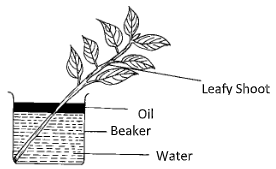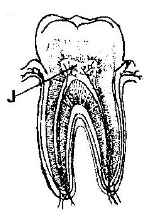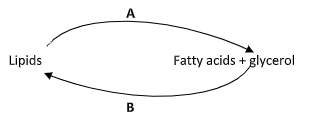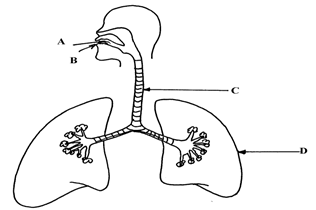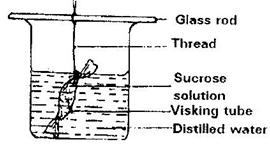- Answer ALL questions in the spaces provided after each question.
- What do you understand by the following terms (2mks)
- Anatomy
- Ichthyology
-
- What is meant by the term Binomial nomenclature? (1mk)
- The scientific name of a toad is bufo regularis.
- Write the name correctly (1mk)
- Identify the genus and species names (2mks)
- Genus name…………………….
- Species……………………………..
- The two cells shown below are obtained from two different potato cylinders which were immersed in tow different solutions P and Q.
-
- Name the structure labelled A. (1mk)
- State the function of structure B . (1mk)
- If eight of cell I were observed across the diameter of the filed of view of 0.5 mm. Work out the actual diameters of each cell in micrometers. (2mks)
(1millimeter =1000micrometer)
- Suggest the identity of the solution Q. (1mk)
- Account for the change in cell I above. (2mks)
- State any one importance of the physiological process being demonstrated above in animals. (1mk)
-
- Study the organelle shown below:-
- Identify the cell organelle above (1mk)
- How is the organelle you have identified in (a) above suited to its function (1mk)
- An experiment shown below was set-up to investigate a certain physiological process in plants:-
- What process was being investigated? (1mk)
- Give the role of the oil layer in this experiment (1mk)
-
- What observation did the students make after leaving the set-up in bright sunlight for two hours? (1mk)
- Explain the observation in (c)(i) above (2mks)
- What effect will the following have on the observation made?:-
- Fanning the shoot (1mk)
- Removing all the leaves from the shoot (1mk)
- Placing the set-up in the dark (1mk)
- State the function of the following cell structures:- (2mks)
- Ribosome ;
- Centrioles ;
- The diagram below represents a section through a human tooth.
- Name the type of tooth shown. (1mk)
- Give a reason for your answer in (a) (i) above. (1mk)
- Below is a process that takes place along the mammalian digestive system:
- Name the processes represented by A and B (2mks)
- Name part of the alimentary canal where the process B takes place (1mk)
- Explain why a fresh wound on the skin bleeds more on a hot sunny day than on a cold chilly day (2mks)
-
- What is Respiration Quotient (RQ)? (1mk)
-
- Calculate the R.Q of the food substance shown by the equation below. (2mks)
2C51H98O6 + 145 O2 → 102CO2 + 98H2O + Energy - Name the food substance being oxidized in b (i) above. (1mk)
- Calculate the R.Q of the food substance shown by the equation below. (2mks)
- The diagram below represents a section of the human respiratory system:
- One can inhale through path A, or B. Giving reasons, state the more appropriate path. (2mks)
- How is the part labelled C adapted for its function? (1mk)
- Explain the effect of regular tobacco smoking to the functioning on the organ labelled D (1mk)
- Define the following terms:- (2mks)
- Autecology
- Biomass;
-
- State two functions of the kidney (2mks)
- Name two substances that are not found in urine of a healthy person (2mks)
- Name two diseases that affect the kidney (2mks)
- An experiment was set up as shown in the diagram below.
The set up was left for 30 minutes.- State the expected results. (1mk)
- Explain your answer in (a) above. (1mk)
- A solution of sugarcane was boiled with hydrochloric acid; sodium carbonate was heated with Benedict’s solution. An orange precipitate was formed.
- Why was the solution boiled with hydrochloric acid? (1mk)
- To which class of carbohydrates does sugarcane belong? (1mk)
- State the form in which carbohydrates are stored in: (2mks)
- Plants………………………………….
- Animals……………………………….
-
- A patient whose blood group is A died shortly after receiving blood from a person of blood group B. Explain the possible cause of death of the patient. (2mks)
- A person of blood group AB requires a transfusion.
- Name the blood groups of the possible donors (2mks)
- Give reasons for your answer in (i) above. (1mk)
- Anestar students wanted to estimate the number of grasshoppers in 5km2 grass field near the school compound. They captured 36 grasshoppers. They used a red felt pen to mark the thorax of each insect before releasing back into the field. Three days later they made another catch of grasshoppers. They collected 45 grasshoppers of which only 4 had been marked with red mark.
- Name the ;
- Above method used in the population estimation (1mk)
- The most appropriate apparatus for capturing grasshoppers (1mk)
- Calculate the population of grasshoppers using the above data (2mks)
- Name the ;
- The table below shows the approximate percent concentration of various components in blood plasma entering the kidney glomerular filtrate and urine of a healthy human being.
Component Plasma Glomerular Urine Filtrate Water
Glucose
Amino Acids
Plasma proteins
Urea
In organic ions90
0.1
0.05
8.0
0.03
0.7290
0.1
0.05
0
0.03
0.7294
0
0
0
2.0
1.5- Name the process responsible for the formation of glomerular filtrate. (1mk)
- What process is responsible for the absence of glucose and amino acids in urine? (1mk)
- Explain why there are no plasma proteins in the glomerular filtrate (1mk)
- Besides plasma proteins what other major component of blood is absent in the glomerular filtrate. (1mk)
- The diagram below represents an organ from a bony fish. Study the diagram and answer the questions that follow:
- State the functions of each of the following (2mks)
- A……………………………………………………………..
- B…………………………………………………………….
- How is the structure labeled C adapted to its function? (1mk)
- State the functions of each of the following (2mks)
- State two reasons why lipids are rarely used as a respiratory substrate compound to Carbohydrates (2mks)


MARKING SCHEME
- What do you understand by the following terms (2mks)
- Anatomy
- Study of internal parts of the body of an organism
- Ichthyology
- Study of fishes
- Anatomy
-
- What is meant by the term Binomial nomenclature? (1mk)
- a system of naming organisms by giving them two scientific names, the generic and the specific names.
- The scientific name of a toad is bufo regularis.
- Write the name correctly (1mk)
- Bufo regularis
- Identify the genus and species names (2mks)
- Genus name…….Bufo
- Species………regularis
- Write the name correctly (1mk)
- What is meant by the term Binomial nomenclature? (1mk)
- The two cells shown below are obtained from two different potato cylinders which were immersed in tow different solutions P and Q.
-
- Name the structure labelled A. (1mk)
- Nucleus
- State the function of structure B . (1mk)
- Stores sugar and salts;
- Maintain the shape of the cell providing support to herbaceous plants
- If eight of cell I were observed across the diameter of the filed of view of 0.5 mm. Work out the actual diameters of each cell in micrometers. (2mks)
(1millimeter =1000micrometer)
0.5×1000
8
= 62.5µm.
- Name the structure labelled A. (1mk)
- Suggest the identity of the solution Q. (1mk)
- Hypotonic
- Account for the change in cell I above. (2mks)
- The potato cell sap were lowly concentrated than the surrounding solution; hence lost water molecules by osmosis through the semi permeable membrane to become plasmolysed;
- State any one importance of the physiological process being demonstrated above in animals. (1mk)
- Absorption of water in the intestines
- Reabsorption of water in kidney nephron.
-
- Study the organelle shown below:-
- Identify the cell organelle above (1mk)
- mitochondrion
- How is the organelle you have identified in (a) above suited to its function (1mk)
- Has cristae/inner membrane highly folded to increase surface area; for respiration.
- Has matrix medium for respiratory activities; (reject (b) if (a) is wrong.)
- Has matrix medium for respiratory activities; (reject (b) if (a) is wrong.)
- Identify the cell organelle above (1mk)
- An experiment shown below was set-up to investigate a certain physiological process in plants:-
- What process was being investigated? (1mk)
- Transpiration
- Give the role of the oil layer in this experiment (1mk)
- prevent evaporation of water from the surface
-
- What observation did the students make after leaving the set-up in bright sunlight for two hours? (1mk)
- the level of water dropped
- Explain the observation in (c)(i) above (2mks)
- Leaves have stomata that loses water via transpiration
- What observation did the students make after leaving the set-up in bright sunlight for two hours? (1mk)
- What effect will the following have on the observation made?:-
- Fanning the shoot (1mk)
- faster drop in water level
- Removing all the leaves from the shoot (1mk)
- no change in water level
- Placing the set-up in the dark (1mk)
- slower/very slow drop in water level;
- Fanning the shoot (1mk)
- What process was being investigated? (1mk)
- State the function of the following cell structures:- (2mks)
- Ribosome ;……Protein synthesis
- Centrioles ; …. Spindle formation during cell division ;
Form cilia and flagella
- The diagram below represents a section through a human tooth.
- Name the type of tooth shown. (1mk)
- Premolar/Molar
- Give a reason for your answer in (a) (i) above. (1mk)
- two roots
- broad surface
- cusp and ridges
- Name the type of tooth shown. (1mk)
- Below is a process that takes place along the mammalian digestive system:
- Name the processes represented by A and B (2mks)
- A……… hydrolysis
- B……… condensation
- Name part of the alimentary canal where the process A takes place (1mk)
- Duodenum
- ileum;
- Name the processes represented by A and B (2mks)
- Explain why a fresh wound on the skin bleeds more on a hot sunny day than on a cold chilly day (2mks)
- On a hot sunny day blood vessels are dilated hence more blood is lost; on a cool chilly day the blood vessels have constricted hence less blood flows on the surface of the skin;
-
- What is Respiration Quotient (RQ)? (1mk)
- The ratio of the amount/volume of Carbon (IV) Oxide produced to that of oxygen consumed during respiration
-
- Calculate the R.Q of the food substance shown by the equation below. (2mks)
2C51H98O6 + 145 O2 → 102CO2 + 98H2O + Energy
RQ = Vol. of CO2 produced
Vol. of oxygen consumed
= 102
145;
= 0.703; - Name the food substance being oxidized in b (i) above. (1mk)
- Fats;
- Calculate the R.Q of the food substance shown by the equation below. (2mks)
- What is Respiration Quotient (RQ)? (1mk)
- The diagram below represents a section of the human respiratory system:
- One can inhale through path A, or B. Giving reasons, state the more appropriate path. (2mks)
Path A (Nose)- has mucous lining which trap foreign particles in air;
- has sensitive cells to smell in nose limit inhalation of poisonous gases;
- air is warmed in the nose before reading the lungs;
- hair in the nose filter solid particles in the air;
- How is the part labbelled C adapted for its function? (1mk)
- Has a lumen/tubular for air passage;
- has mucous membrane to trap foreign particles and filter dust;
- Has cartilage to prevent collapsing / to keep it open;
- Has elastic muscles to allow compression and flexibility;
- Explain the effect of regular tobacco smoking to the functioning on the organ labelled D (1mk)
- Soot/smoke particles block the passage (bronchi/alveoli) of the gases; may cause cancer
- Stimulate the epithelium membrane/lining to secrete a lot of mucus which may block the passage;
- One can inhale through path A, or B. Giving reasons, state the more appropriate path. (2mks)
- Define the following terms:- (2mks)
- Autecology….
- is the study of population / study of members of one species;
- Biomass;
- The dry weight of an organisms in a given habitat
OR - Biomass is the quantity of matter of a given type of organisms at a given trophic level;
- The dry weight of an organisms in a given habitat
- Autecology….
-
- State two functions of the kidney (2mks)
- Excretion;
- Osmo-regulation;
- Ionic balance
- Name two substances that are not found in urine of a healthy person (2mks)
- Glucose
- Amino acids;
- Name two diseases that affect the kidney (2mks)
- Nephritis;
- kidney stones /Gall stones;
- Hepatitis A and B;
- State two functions of the kidney (2mks)
- An experiment was set up as shown in the diagram below.
The set up was left for 30 minutes.- State the expected results. (1mk)
- The visking tubing was fully filled with solution.
- Level of water in beaker decreased .
- Explain your answer in (a) above. (1mk)
- Sucrose solution in visking tubing created high concentration gradient.
- Water molecules moved from distilled water to the visking tubing by osmosis
- State the expected results. (1mk)
- A solution of sugarcane was boiled with hydrochloric acid; sodium carbonate was heated with Benedict’s solution. An orange precipitate was formed.
- Why was the solution boiled with hydrochloric acid? (1mk)
- HCl — to hydrolyse complex sugar to simple sugar
- To which class of carbohydrates does sugarcane belong? (1mk)
- Disaccharides
- State the form in which carbohydrates are stored in: (2mks)
- Plants……Starch
- Animals…Glycogen
- Why was the solution boiled with hydrochloric acid? (1mk)
-
- A patient whose blood group is A died shortly after receiving blood from a person of blood group B. Explain the possible cause of death of the patient. (2mks)
- The patient’s red blood cells have antigen A on their membrane and his plasma has anti-b antibodies .The donor’s red blood cells have antigen B on their membrane and his plasma has anti-a antibodies. After transfusion, the anti-b antibodies in the patient’s plasma reacted with B antigens on the donor’s red blood cell membrane. This led to clumping together of the donor red blood cells a process called haemagglutination. This may have caused blockage of capillaries in a vital organ like the heart or brain leading to death.
- A person of blood group AB requires a transfusion.
- Name the blood groups of the possible donors (2mks)
- A,B,AB,O
- Give reasons for your answer in (i) above. (1mk)
- He is universal recipient. His plasma' lacks antibodies.
- Name the blood groups of the possible donors (2mks)
- A patient whose blood group is A died shortly after receiving blood from a person of blood group B. Explain the possible cause of death of the patient. (2mks)
- Anestar students wanted to estimate the number of grasshoppers in 5km2 grass field near the school compound. They captured 36 grasshoppers. They used a red felt pen to mark the thorax of each insect before releasing back into the field. Three days later they made another catch of grasshoppers. They collected 45 grasshoppers of which only 4 had been marked with red mark.
- Name the ;
- Above method used in the population estimation (1mk)
- Capture –recapture method;
- The most appropriate apparatus for capturing grasshoppers (1mk)
- sweep net
- Above method used in the population estimation (1mk)
- Calculate the population of grasshoppers using the above data (2mks)
P = FM x SC
MR
= 36 x 45;
4
= 405
- Name the ;
- The table below shows the approximate percent concentration of various components in blood plasma entering the kidney glomerular filtrate and urine of a healthy human being.
- Name the process responsible for the formation of glomerular filtrate. (1mk)
- Ultrafiltration;
- What process is responsible for the absence of glucose and amino acids in urine? (1mk)
- Selective reabsorption;
- Explain why there are no plasma proteins in the glomerular filtrate (1mk)
- Proteins have large molecular weights hence not ultrafiltrated
- Besides plasma proteins what other major component of blood is absent in the glomerular filtrate. (1mk)
- Blood cells eg RBC ,WBC,Platelets
- Name the process responsible for the formation of glomerular filtrate. (1mk)
- The diagram below represents an organ from a bony fish. Study the diagram and answer the questions that follow:
- State the functions of each of the following (2mks)
- A…– Gill filaments – the surface on which gaseous exchange take place
- B…… Gill bar for attachment of gill rakers and gill filament
- How is the structure labeled C adapted to its function? (1mk)
- Teeth like to act as a screen preventing entry of food and other particles that might damage the delicate gill lamella;
- State the functions of each of the following (2mks)
- State two reasons why lipids are rarely used as a respiratory substrate compound to Carbohydrates (2mks)
- Insoluble hence not easily transported to respiratory sites;
- They require more oxygen to be oxidized;
Join our whatsapp group for latest updates
Tap Here to Download for 50/-
Get on WhatsApp for 50/-
Download Biology Questions and Answers - Form 3 Term 1 Opener Exams 2023.
Tap Here to Download for 50/-
Get on WhatsApp for 50/-
Why download?
- ✔ To read offline at any time.
- ✔ To Print at your convenience
- ✔ Share Easily with Friends / Students



